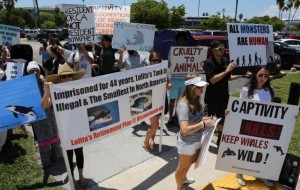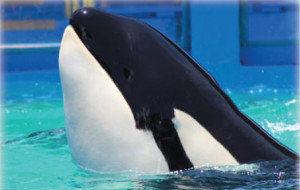— by Lin McNulty —
Animal rights activists gathered on Sunday at Miami, Florida’s Seaquarium where our own Pacific Northwest orca, Lolita, has been held in captivity for 43 years.
Animal rights groups seeking the release of Lolita, a killer whale in captivity since 1970, sued the Miami Seaquarium and its parent company Palace Entertainment on July 20, 2015, saying her conditions violate the Endangered Species Act.
Forty-five years ago over 100 orcas were herded into Penn Cove (near Coupeville on Whidbey Island). The young ones were netted and hauled into trucks for theme parks worldwide. By 1987, all but one — Lolita — has died. She is still alive.
Besides Lolita being in captivity, the concern of the activists is further complicated by her surroundings; the size of her tank measures 80 feet long, 60 feet wide, and only 20 feet deep. It is one of the smallest whale enclosures in the world. She has also been without another orca since 1980 when her tank mate, Hugo, died.
While Lolita is required to perform for the crowds seven days a week, the Seaquarium said Lolita is well cared for and has been in captivity for so long that releasing her would be “cruel and traumatic.” (Reuters)
“For more than 40 years, Lolita has been unable to swim any meaningful distance, dive, forage, or carry out virtually any natural behaviors,” said the complaint, filed in the Southern District of Florida by People for the Ethical Treatment of Animals (PETA).
Opponents of the release plan also argue she could face a fate similar to Keiko, the orca who starred in the 1993 movie “Free Willy.” Although Keiko was released off Iceland, near where he was originally captured in 2002, he died the next year after being rejected by wild killer whales.
There is no easy answer, is there? Lolita’s release may mean certain death based on past experience with Keiko. Continued captivity, along with her performance schedule, may also eventually shorten her life span.
While it may be romantic and endearing to think of Lolita being freed and happily swimming away with her original pod, and living the good life in the Salish Sea for another 35 years, the chances of her surviving release seem to be less than staying in captivity.
We need to accept the fact that we screwed up with the initial capture of orcas for display and allow Lolita to stay where she is as a living reminder that we should never let that happen again.
SOURCES:
https://www.miamiherald.com/news/local/community/miami-dade/key-biscayne/article30552159.html
https://www.orcanetwork.org/Main/
https://www.reuters.com/article/2015/07/20/us-usa-whale-lolita-idUSKCN0PU23C20150720
**If you are reading theOrcasonian for free, thank your fellow islanders. If you would like to support theOrcasonian CLICK HERE to set your modestly-priced, voluntary subscription. Otherwise, no worries; we’re happy to share with you.**









“Allow Lolita to stay where she is”?-it’s not like she has a choice.
No, but we as her human “owners” do. Lin is right, there is no easy answer to this.
Given a choice of remaining incarcerated after 40+ years or freedom, even if it meant a difficult life and/or possible death, there are damn few that wouldn’t choose freedom if only for a little while. “Performing” seven days per week for 40 years, isn’t that enough of a sentence?
Well said, John. I too would choose freedom.
Because whales are said to be at least as smart as we are, most likely smarter – just ask what you would choose if you were in her situation.
Being an captured indentured slave for most of your life, being ripped away from your family and place in an unnatural tiny cell, forced to do tricks.
What would you want to do with the rest of your finite amount of hours on earth, even if knowing that the road back was not easy and a bit dangerous? Only a coward would choose to not go back to the place and community that they remember as just a dream from the past. Orca’s are not cowards. To me, there is no question at all. The powers that be just need to hurry up and get her out of there.
I’m with you Janice
FREE LOLITA ❤️
Notwithstanding the levels of intelligence and consciousness attributed to our Orcas, the unaddressed issue at the heart of the matter is…after 40 years of being “spoon-fed” along with a single tank-mate, are the skills of hunting and foraging up to the task of providing an adult Orca w/ sufficient food to sustain it?…and what about the social skills necessary for gaining acceptance within a pod?
Might not there be a third option…?…such as, termination of the 7 days a week performance schedule, release into a large but contained body of water, some level of continuing contact w/ knowledgeable humans to monitor Lolita and feed her if necessary…and depending on the results, allow for a further transition into the open sea.
What do our local Orcas experts have to say about this?
Even if there are risks, aren’t we morally compelled to give Lolita the chance? Doesn’t she deserve some measure of what she’s been denied? Can even the risk of failure outweigh the opportunity for her to spend her last years off-display with some degree of autonomy and self-determination? And of course, she wouldn’t simply be dumped into the ocean. The process would be a considerable undertaking, with marine biologists, animal behaviorists, and scientists involved in her rehabilitation. Such a process has successfully happened with Keiko, who lived five healthy years, navigated more than 1,000 kilometers of open ocean, and was living freely when he died on December 12, 2003.
FREEDOM! at any cost <3,
and probably a transitional net pen "large"
Speaking here is someone who has been a career naturalist for 25 years.
Life is NOT about just being “safe.” I have followed this issue and Keiko’s story and many other wild and captive populations around the world over decades. There is an extensive many stepped plan for preparing Tokitae-Lolita to move, to situate her in a sea pen at San Juan Island and go through all the stages that might or might not realize her reintroduction joining her mother and other wild L pod whales. Keiko did live a year as a free sovereign being making his free will choices as we all have the right to do. That he died of an illness one month, one year or ten, does not negate that he was free to live as he wished. He did not remember his pod’s dialect as Tokitae- Lolita does and that is one very important key to a reintroduction to a whale’s wild family.
President Lincoln was witnessed to wade into a river near where he was about to address the public to save a pig that would surely have otherwise drowned. He said he did not do it just for the pig’s sake but for his own; his moral compass of compassion dictated such an action.
I could go on and on but I’ll spare you. Thanks for listening
Freedom, or death from terminal loneliness? No cetaceans should be taken, nor kept in tanks. Duh. They are sentient, family and pod oriented gentle giants.
Keeping Lolita imprisoned just allows the SeaWorlds to pretend that keeping and displaying whales is appropriate and somehow good. They need to release her and all of the descendants of the Penn Cove harvest.
Should we eliminate zoos? Which animals is it acceptable to keep captive? Should we free Lolita only? Why not all whales?
I’m for eliminating zoos. Most animals are kept in miserable conditions. We now have wonderful video of virtually all species in the wild. And, yes, of course, free all of the whales that are held as circus performers.
No, leaving her in solitary confinement in tiny chlorinated tank and forcing her to perform silly tricks for gawking tourists is the right thing to do.
That was sarcasm in case you missed it.
All orcas deserve freedom. And who wants to see lonely, miserable, stressed captive animals behaving how abusement parks force them to? That’s not entertaining or educational.
I sure hope an Animal Communicator is on hand during this transition to her new (old life)! Remember Mary Getten, the Animal Communicator from Orcas who communicated with the SJ Island’s Whales and wrote books about it? She moved to Florida.
She or someone like her could help a lot in this transition for Lolita.
Spirit Eagle